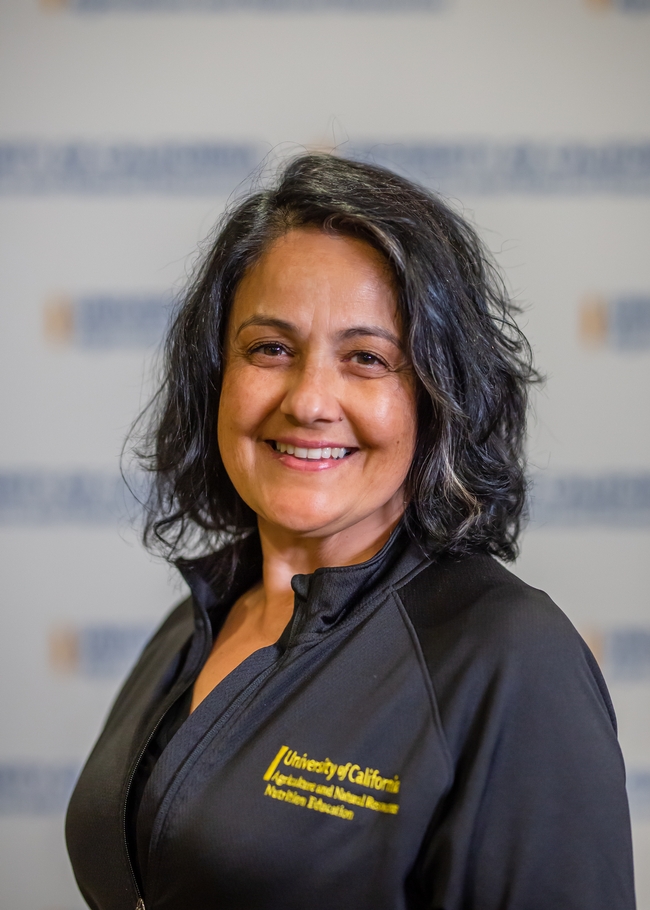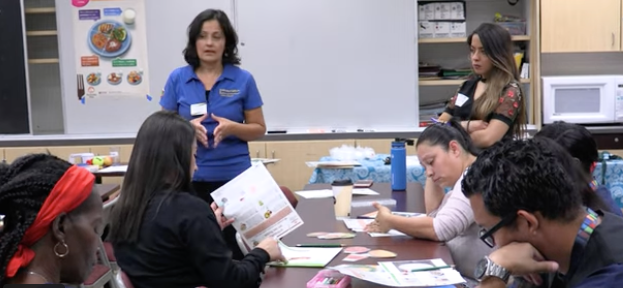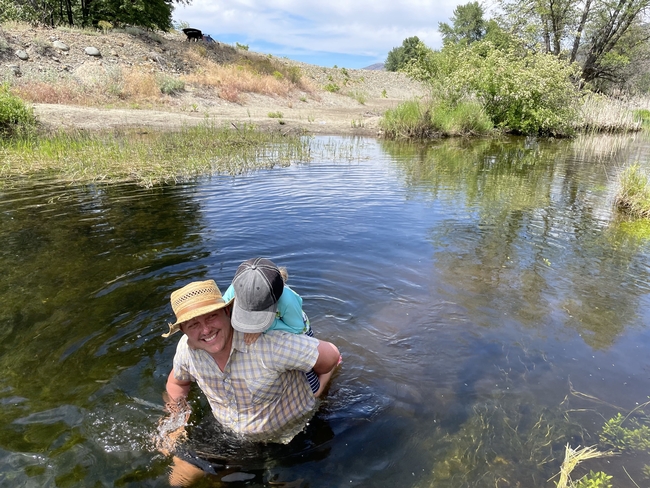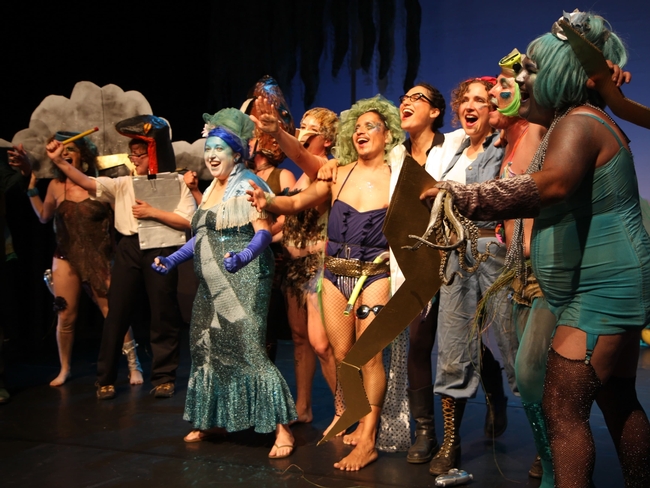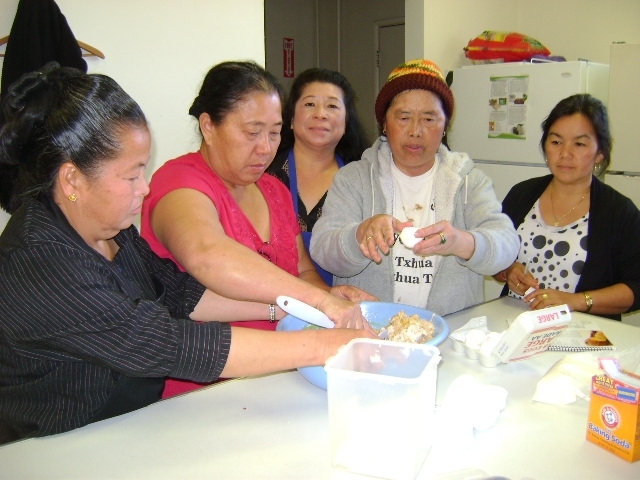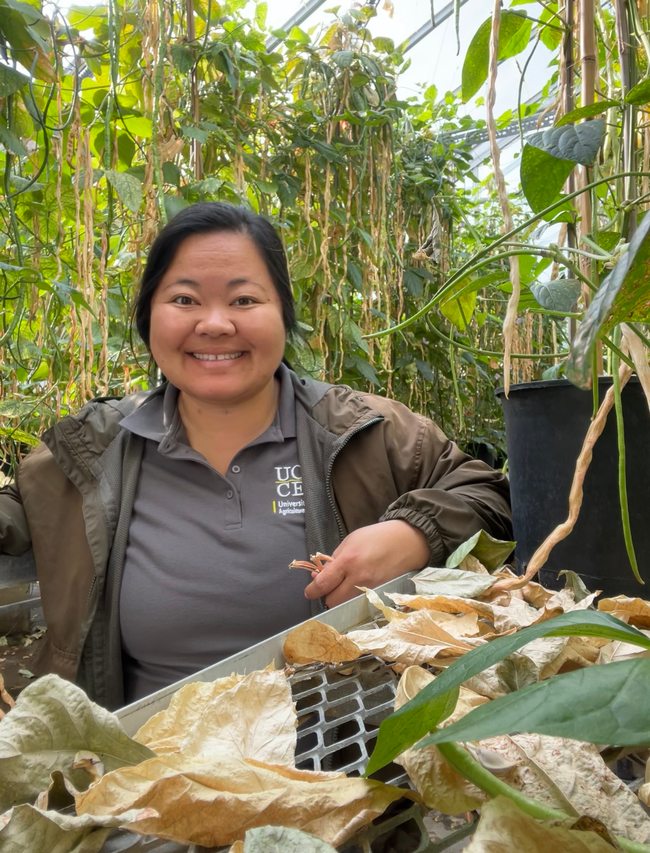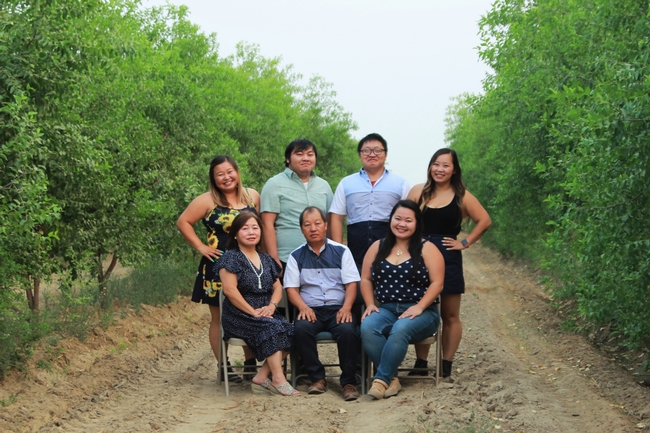- Author: Ricardo Vela
On a sunny morning in San Bernardino, Clara Wilshire, with palpable energy and a warm smile, greets the participants of her nutrition class, part of the EFNEP (Expanded Food and Nutrition Education Program) at the University of California Cooperative Extension office.
“Good morning. My name is Clara Wilshire, and I'm from the EFNEP program of the University of California Cooperative Extension,” she says enthusiastically, kicking off the day with a light exercise session that sets the tone for learning about nutrition and healthy habits.
With over 30 years of experience with Cooperative Extension and 24 years dedicated to the adult EFNEP program, Wilshire has devoted her life to teaching the Latino community in San Bernardino about the importance of good nutrition and regular exercise. However, in the early days of her career, connecting with her students was not always easy.
“I knew I had to teach them this nutrition curriculum, but I struggled to connect with the parents,” Clara recalls. “But as my family grew and I became a more experienced mother, it became much easier to give recommendations and share my personal stories with my participants.”
This connection, rooted in personal experiences and a deep understanding of the realities faced by the community she served, has become one of Wilshire's greatest strengths as an educator. Over time, she has witnessed the significant impact her classes have had on the lives of residents in San Bernardino County.
“I've seen an impact,” Wilshire says with a blend of pride and humility. “I've heard stories of people making their food money stretch further or their EBT card lasting longer without having to rely so much on food banks to get through the month. I've also heard people say they started drinking fewer sodas or sugary drinks, and some have even noticed they began losing a bit of weight by making those small changes in their lives.”
But Wilshire's connection to the EFNEP program goes beyond her professional career. She herself had the opportunity to participate in the program as a child, although she didn't make that connection until years later. “My aunt had a nutrition educator who visited her home, and my mother was able to participate in that program. I didn't make the connection until I was on the job. I pulled out an old recipe and recognized the letterhead; it was one of the recipes my mom used to get from the educator.”
With her unwavering commitment to serving the Latino community, Wilshire decided to expand her impact by enrolling in the Master Food Preserver program when she realized there were not enough Spanish-speaking instructors. “Throughout all the years I've been working, I realized that all the classes offered by the Master Food Preserver program had been in English. As I became more interested in food preservation, I thought I had the experience of being an educator. I felt very comfortable speaking in front of people and thought I could do this. I could teach these classes too.”
Wilshire's interest in food preservation is not new; it is deeply rooted in her Latino heritage, in the traditions her mother passed down, like preserving nopalitos, a traditional Mexican dish. This pride in her culture is reflected in her approach to teaching and her participation in Hispanic Heritage Month celebrations.
“Having this time to reflect on our culture, family, history, and food is a moment to be proud of who we are,” Wilshire says. Her words encapsulate the passion and commitment she has demonstrated throughout her career, always striving to empower the Latino community to adopt healthier lifestyles.
Clara Wilshire is more than an educator; she is a tireless advocate for her community. She has dedicated her life to improving the health and well-being of others while honoring and celebrating her Latino heritage. Through her work, she continues to be an inspiration and a shining example of how education and culture can intertwine to create a lasting impact on people's lives.
- Author: Michael Hsu
UCCE advisor outreaches to LGBTQ+ community, partners with Karuk Tribe in Northern California
Costumed as river creatures with papier mâché heads and dressed as the Army Corps of Engineers, Cleo Woelfle Hazard and a performance art group called The Water Underground dazzled the biennial Bay Delta Science Conference a few years ago.
Woelfle Hazard – then a Ph.D. student at the University of California, Berkeley – and his companions performed numbers from the film they were making, a “queer slapstick musical” about salmon migration. They soon got 150 scientists, engineers, resource managers and other conference attendees singing along to their songs.
“Meanwhile, some of my professors were in the audience, and they were saying, ‘Well, he's also a scientist, he doesn't just do this art stuff!'” recalled Woelfle Hazard, who started at the beginning of this year as the UC Cooperative Extension fire advisor for Humboldt and Del Norte counties.
Identifying as a “queer trans masculine person,” Woelfle Hazard has spent much of his career bringing together gender studies with his professional interests – a quest chronicled in his book “Underflows: Queer Trans Ecologies and River Justice.”
Prescribed burn training to help shape queer fire ecology
In his new role, Woelfle Hazard is organizing a prescribed burn training for people who are 2SLGBTQ+ (2S is a common abbreviation for Two-Spirit, which refers to people of Indigenous North American descent who identify as having both masculine and feminine qualities). The sessions, which began in the middle of Pride Month in June, will continue over three more weekends in the fall when participants conduct forest thinning and prescribed burns.
Inspired by the WTREX (Women-in-Fire TRaining EXchanges) burn trainings for women organized by UC ANR Fire Network Director Lenya Quinn-Davidson and her colleagues, Woelfle Hazard is excited to grow skills and foster connections within the LGBTQ+/Two-Spirit community.
“I try to be ‘out' in different contexts that are not particularly queer,” Woelfle Hazard said. “And the queer burn training is one way that I'm trying to increase the visibility of queer people in fire.”
He has been overwhelmed by interest in the training – with over 100 people already registered – and is looking forward to learning how subcultures within those diverse communities can contribute to a nascent “queer fire ecology.”
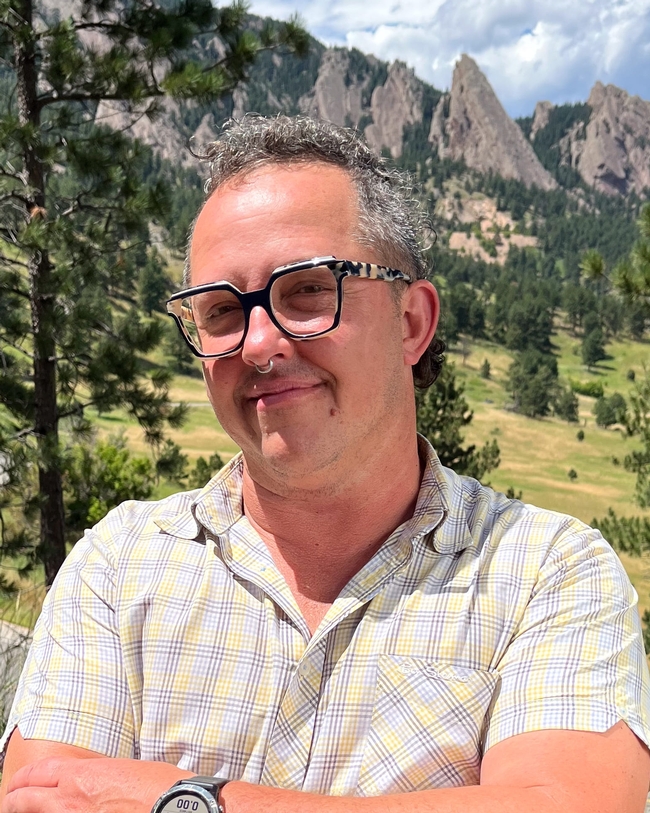
“I do social science and I do ecology, but my core field is feminist science and technology studies,” Woelfle Hazard explained, “which is a field where we're looking at the social context of science and who asks the questions and how the questions change if a Native person, or a Black person, or a queer person, or an immigrant is asking those questions.”
Working alongside Karuk Tribe on Klamath River floodplain restoration
The book “Underflows” also explores the intersectionality of queer theory with Indigenous conceptions of kinship and belonging – building on Woelfle Hazard's extensive experience working with tribal communities.
During his undergraduate years, Woelfle Hazard edited an anthology, “Dam Nation: Dispatches from the Water Underground” and contributed a chapter on tribal-led dam removal efforts, including those of the Karuk, Hoopa, Yurok, and Klamath Tribes in the Klamath Basin. In graduate school, he also participated in the UC Berkeley-Karuk Collaborative, started by UCCE specialist Jennifer Sowerwine and others.
Later in his career, as a faculty member at the University of Washington, Woelfle Hazard had an opportunity to work more directly with the Karuk Tribe. Seeking to bring students to the region for field sessions, he contacted Lisa Morehead-Hillman, who directed the Píkyav Field Institute, the educational wing of the Karuk Department of Natural Resources.
In return, she asked if there was a way her Karuk students could benefit from the experience as well – and Woelfle Hazard said he would be glad to host them in Seattle. “She had never had anyone from a university make that offer before, so that was really the foundation of building trust,” he said.
From there, Woelfle Hazard connected with Leaf Hillman, the founder of the Karuk Department of Natural Resources, and they co-developed a project to look at how reconnecting the Klamath River with its floodplain could restore ecological processes and eco-cultural practices such as basketry.
Working alongside Morehead-Hillman and University of Washington students Jocine Velasco and Ry Yahn, they produced a Storymap, patterned after the Karuk creation story of “Coyote's Journey,” recounting the historical impacts of mining, dams and fire suppression in the region. They are now working on a follow-up Storymap that will describe the tribe's plans to restore the floodplain and revitalize the Tishániik ceremonial site.
Navigating intersections of science, culture
Earlier this month, Woelfle Hazard brought climate scientists from the National Center for Atmospheric Research (NCAR) to Orleans in Humboldt County, where the Karuk Department of Natural Resources is located. NCAR scientists had developed a climate model that describes changes to the Klamath Basin under a variety of future fire regimes, and Woelfle Hazard presented on how well the model meets the needs of local communities.
“Our activity kind of broke their model, which they're pretty happy about, actually,” Woelfle Hazard said. “There's a lot of learning just about what is actually useful for the tribe and other organizations; we're working with the Western Klamath Restoration Partnership, which is a tribal-led partnership with the Forest Service and a number of NGOs in the Klamath Basin.”
As part of the NCAR Innovators project, which intentionally pairs social scientists with NCAR scientists, Woelfle Hazard also studied the researchers themselves, interviewing them about their experiences and looking at ways they can better partner with tribes and grassroots organizations.
“It's been a really complex project, putting together lots of different forms of knowledge – Karuk science, climate science, and I'm in the middle, trying to translate between them,” Woelfle Hazard said.
Native and Western ways of knowing. Social sciences and natural sciences. Fire and water. Artist and scientist. In work and in life, Woelfle Hazard has sought to deconstruct binaries that obscure more complicated realities – and blur those distinctions to illuminate greater truths.
During Pride Month and throughout the year, he said it's important to celebrate progress while also continuing to fight so all people can secure their basic rights and live their lives with dignity and purpose.
“Queer ecology is another frontline of the struggle; if you're a queer/trans/Two-Spirit person and you want to be a fish ecologist, you should be able to be a fish ecologist,” he said. “You shouldn't have to worry that people are going to be saying some stuff while you're out in the field getting into your wetsuit!
“This is work that we all have to do – dismantling these structures of racism, of sexism, of homophobia. And we have to do it all the time, every day.”
- Author: Ricardo Vela
For more than 30 years, Sua Vang has dedicated her time to improving the health of the Hmong community in Fresno County.
"I moved from San Diego in 1986,” said Vang, who, with a nursing degree, took on the challenge of engaging the Hmong community through the Expanded Food and Nutrition Education Program. “At that time, EFNEP was looking for two nutrition educators."
Every day, Sua Vang, an EFNEP community health specialist with the University of California Cooperative Extension in Fresno County, wakes up ready to do her best for her community.
Fresno County is home to 35,000 Hmong, the second-largest population of Hmong in the United States, according to the Pew Research Center.
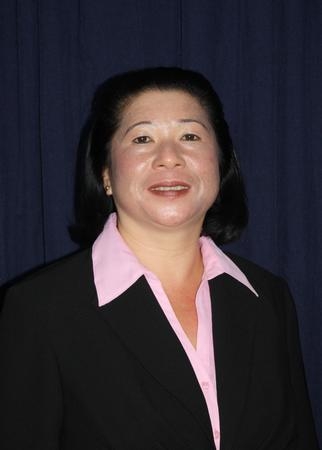
"My biggest challenge was that I didn't know much about nutrition. I had graduated as a vocational nurse, so I had to go through a lot of nutrition training," Vang explained.
The EFNEP specialist also recalled that she had to learn how to keep a 24-hour food log and go door-to-door to recruit participants. It was not an easy road, but Vang has become a trusted and significant community educator within EFNEP because of her vast experience successfully reaching out to the Asian community. She communicates in four languages – Hmong, Lao, Thai and English – with the Southeast Asian community.
Vang has overcome many challenges, but one remains constant.
"A lot of the community members don't do a lot of physical activity; they're indoors, they don't exercise much, so diabetes has a high prevalence among the Hmong community," Vang said. “Some people still use butter and a lot of rice; there's no variety in their diet."
Vang has no regrets about talking nutrition to her family and anyone else who wants to listen. It is essential to her that not only her family but also everyone in her community who participates in the EFNEP classes learn to create healthy eating habits.
- Author: Diana Cervantes
From her Hmong family's roots to the vast expanses of Fresno's fields, Lilian Thaoxaochay weaves a story of unwavering commitment to the land and community. Thaoxaochay shares her knowledge of revitalizing and strengthening agriculture in the San Joaquin Valley, acquired from her childhood among crops to her academic training in medical anthropology and agriculture.
Thaoxaochay, who grew up in the San Joaquin Valley, joined the UC Agriculture and Natural Resources (UC ANR) three years ago as a UC Cooperative Extension community educator for small farms in Fresno County. Since then, Thaoxaochay has extended a helping hand to small-scale Southeast Asian farmers.
When she joined UC ANR in 2021, she became part of an integrated team addressing the COVID-19 pandemic. Because most information about COVID-19 was in English, Thaoxaochay and her team translated information about the vaccination process into other languages for farmers in the region. Her Hmong heritage came in handy for the task.
"We went out into the countryside to raise awareness among residents about the importance of getting vaccinated," explained Thaoxaochay, "The Hmong community faces barriers such as language and culture."
She is a first-generation Hmong American in her family of six generations of hard-working farmers. While Thaoxaochay helped on the farm as a child, she absorbed every detail of farm life. Over time, her love of agriculture and interest in human culture and society gave her a new vision for her future.
Determined to explore this connection more deeply, Thaoxaochay embarked on an academic journey that led her to earn a bachelor's degree in medical anthropology at Stanford University and later a master's degree in Southeast Asian agriculture at the University of California Santa Cruz. Armed with her deep knowledge of both the field and the community, Thaoxaochay returned to the San Joaquin Valley with renewed purpose. Besides helping on the family farm, she dedicated herself to sharing her knowledge and experiences with other farmers and community members.
Through workshops, talks and research projects, Thaoxaochay addresses the various challenges small-scale farmers face in the valley, ranging from water scarcity to environmental and economic concerns. She advocates for solutions that will benefit farmers and the community.
Her strong ties to the Hmong community have contributed to her successful career with UCANR. "Part of my success is growing up on a farm in the San Joaquin Valley, which allows me to understand the needs of smallholder farmers," says Thaoxaochay.
"I was asked to see a farmer to help calculate crop loss due to the drought," she said. "However, no one had thought to ask about why these crops had died specifically. We then realized it wasn't just because of heat and insufficient water, but rather almost no water at all because his pump had died and been pulled out completely and he didn't have the means or know-how to fix the issue. This is a very serious example of how growers in our region were impacted by drought - fluctuating water tables (especially lowered ones) causing pump damage and growers not having the resources to diagnose the issue before it becomes a very difficult situation."
Over time, Thaoxaochay's work has strengthened the bonds between farmers and the community. Her story is about a young woman who grew up in the fields and became a passionate advocate for her community. She has become known for her dedication, knowledge and love for the land.
Thaoxaochay has been influenced by strong women including Yuri Kochiyama, a Japanese-American who was incarcerated with her family in a concentration camp in Arkansas during World War II and began championing civil rights for Asian American, Black and Third World people in the 1960s. "I have great admiration and respect for activist Yuri Kochiyama, whom I met in 2008 at a dinner," she recalls.
And while the age difference between Lilian and Kochiyama is significant—at least 69 years apart—the two share the same thinking. As Asian American women, they both pursue a passion for community and justice.
"Yuri's legacy drives my determination to represent and express the needs of those I serve," Thaoxaochay said.
In May we celebrate the contributions of Asian Americans and Pacific Islanders, recognizing their power, courage and resilience. Thaoxaochay, who is paving the way for future generations, invites other Asian women not to be afraid to take risks. "Mistakes don't mean failure. Rather, they offer opportunities and possibilities for empathy, growth and development, which I consider important lessons in pursuing any dream."
- Author: Saoimanu Sope
In celebration of Black History Month
Through music, movies and other media, many people know about Compton, a city located in southern Los Angeles County. Keith Nathaniel knows it from firsthand experience. Before Nathaniel and his family moved to Compton in the 1970s, the LA Watts Riots of 1965 underscored the tension brewing between law enforcement and the Black community that was felt not just in California but nationwide.
“Before we moved, Compton was changing from a predominantly White city to a Black city. The Watts Riots changed that and suddenly, you've got White flight out of Compton and into the suburbs,” said Nathaniel, UC Cooperative Extension director in Los Angeles County.
Growing up, Nathaniel was surrounded by people who looked like him. “It was a typical community of people who supported each other. The adults knew each other, and the kids knew each other,” he said.
Nathaniel remembers his teachers in elementary and middle school, identifying them as first-generation college students – most of whom graduated from universities following the 1954 civil rights case, Brown vs. Board of Education, which resulted in the desegregation of public schools across the United States.
“Those teachers had this real desire for us to match, if not exceed, their success or level of educational attainment,” said Nathaniel. “They were committed to seeing us become healthy and thriving adults.”
Although Nathaniel and his peers had influential Black leaders in their schools, prioritizing academic success was challenged by the introduction of crack cocaine. “With drugs came influx of gangs. Then, you start to see the community become unstable because gangs want to control this block or that corner,” Nathaniel said.
“We used to have shootouts at our high school. But it was Black and Brown lives being affected so it wasn't newsworthy in that sense. Not like today where you see an epidemic of school shootings making the news. This was happening back in the day, too,” he said, emphasizing that he and his peers were constantly reminded to be cautious while out at social events in the community.
“It was scary to think that you could be mistaken for being in a gang even if you had no ties.”
Students that were once friends in elementary or middle school became enemies by the time they started high school. Although Black boys were highly favored as gang recruits, Nathaniel said that his strong family foundation and focus on academics kept him out of the crossfire that others stepped into.
After graduating from high school, Nathaniel started college at UC Davis, where he pivoted to sociology after realizing that engineering was not for him. “I intended to graduate with a degree in engineering, but it was so competitive. I was in classes with pre-med students, and they were jacking up the grading curve,” he joked.
What Nathaniel did not realize prior to college, however, is that academic aptitude would not be the most important aspect of his experience in education. It was also the connections and relationships he built with others. Reflecting on the five years he spent at UC Davis, Nathaniel said that it was the best five years of his young adulthood.
Grateful for the teachers and advisors that kept him grounded, Nathaniel decided he wanted to become a teacher himself. From Davis, he pressed on for his master's degree at Florida A&M University where he studied educational leadership. Despite his high school advisor discouraging Black students from attending a historically Black university or college, Nathaniel felt the urge to do just that.
“My advisor was just incredible. Her goal was to get everyone to college,” said Nathaniel. “But she didn't like the idea of us going to an HBCU because it's not how the real world looks. She would tell us that it's better for us to integrate ourselves on campuses that reflect the world we live in.”
During graduate school, Nathaniel's mother died, and he returned to California. Although his loss led him to believe that returning to school was not ideal at the time, Nathaniel said that his professors reached out to him while he was away, and their concern swayed him.
“They checked up on me and it made me realize how much support I had back in Florida. I'm pretty sure this wouldn't have been the case if I wasn't attending an HBCU,” Nathaniel said.
He went back to Florida to finish what he started. While earning a master's degree, Nathaniel said he was encouraged to pursue a doctorate degree and he seriously considered it, but not immediately. By then, his vision evolved into becoming a principal or superintendent and expanding his influence beyond the classroom. “I wanted a seat at the table, but I knew that I needed the credentials first,” he said.
Upon returning to California, Nathaniel applied for teaching positions and stumbled upon an ad in the Los Angeles Times seeking applications for a 4-H program coordinator. He was not offered the position he applied for, but he was offered a coordinator role for the Americorp/VISTA volunteer program instead and willingly accepted.
Since 1994, Nathaniel has been a part of UC Cooperative Extension and started out by managing the Americorp/VISTA volunteers who were responsible for introducing the 4-H program to communities across Los Angeles. The program grew quickly, engaging 4,000 to 5,000 kids daily. The power of the program was not just in its passionate volunteers, but the fact that the volunteers lived in the communities they served.
Prior to 4-H, Nathaniel worked for the Campfire Council and was introduced to informal education such as teaching youth in life skills and connecting with them outside of the traditional classroom. This experience served Nathaniel well as he transitioned into 4-H, inspiring him to pivot from his original goal of working in the formal K-12 system.
In 1997, Nathaniel was accepted to UCLA where he earned a doctorate of education while working full-time. “Going back to that seat at the table… by this time in my career, I knew that I wanted to influence policy that would benefit young people. I wanted to do more than teach. And I also knew that I needed the credentials to do it,” said Nathaniel.
Now, Nathaniel enters his 30th year of service to the community through UC Cooperative Extension. Realizing how far he has come, Nathaniel said that the adversity of his childhood helped build his character and prepared him for the battles ahead.
Emphasizing the significance of connecting with people, Nathaniel said that it is fulfilling to serve the community that raised him and credits the mentors and peers he has met along the way for his triumphs.
“If we surround ourselves with people that have our best interest in mind, we'd believe that we're going places,” he said. “It's about being selfless, too. So that we can help others see themselves the way we see them; so they feel empowered to do whatever it is they want to do. That's what I had, and that's what I hope to give back.”

